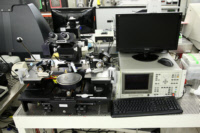Equipment
| Lab and Coral Name | TRL / IV-probe |
| Model | Tektronics |
| Specialist | Bernard Alamariu (David Terry) |
| Physical Location | 4F Main-North |
Classification
| Process Category | Metrology |
| Subcategory | Electrical |
| Material Keywords | CMOS Metals, Non-CMOS Metals |
| Sample Size | 8" Wafers, 6" Wafers, 4" Wafers, 7" Photo Plates, 5" Photo Plates, Pieces |
| Alternative | None |
| Keywords | single wafer, manual load, top side of sample, manual operation, alignment |
Description
The IV-probe is a 6" probe station with microscope, and two Cascade positioners as well as additional probes for measuring DC characteristics of devices during processing. Measurements are done from the PC using Agilent software that connects to the probe through a U2722A measurement unit. Maximum voltage of 20V can be applied. Typical measurements performed include FET and BJT current-voltage sweeps, diode characterization, as well as contact resistance measurements.
| Best for | Quick IV test; via hole etch test |
| Limitations | For three or four terminal measurements, it may matter which terminals use the two high-quality positioners |
| Characteristics/FOM | 20V, 120mA, four terminals |
| Caution with | Do not damage probe tips by crashing them into the substrate. Damaged tips can have very poor contact resistance, and will need replacement. |
| Machine Charges | 2/hour |
Documents
SOP
| Probe station | SOP for the TRL probe station |
Documents
| DC Probe Tips | Data sheet for DC probe tips |
| HP4145B | User manual for HP4145B |
Process Matrix Details
Permitted
Been in the ALDSamples that have been in any of the ALD systems
, Pyrex SubstratesPyrex substrates can be a concern due to high sodium content, which contaminates CMOS frontend tools
, III-V SubstratesAny III-V substrates, e.g. GaAs, GaN, InP, and so on. Note though that many common III-V substrates will also carry the Au flag, but there are some GREEN III-V substrates.
, Germanium on surfaceSamples with germanium on the surface (typically grown films)
, Germanium buriedSamples with germanium buried below a different film
, PiecesWafer pieces may not be handled by the equipment, and are harder to thoroughly clean - preventing them from running in certain tools.
, Gold or RED color codeRED color code substrates. These are gold-contaminated or have been processed in gold contaminated tools. Gold and other metals can contaminate silicon devices (GREEN color code) and have to be separated.
(Adds), Any exposure to CMOS metalIf the sample had ever seen a CMOS metal (or a tool that accepts CMOS metal), then some frontend tools could be contaminated by this.
, CMOS metal on surfaceCMOS compatible metals exposed on the surface. These are Al,Ni,Pt,Ti,TiN. Other metals such as Au are *NOT* part of this.
, CMOS metal buriedCMOS compatible metals covered entirely by a different material. These are Al,Ni,Pt,Ti,TiN. Other metals such as Au are *NOT* part of this.
, Been in the STS DRIEThe DRIE etch leaves behind polymer residues on the sidewall ripples, which can be a contamination concern for some tools.
, Been in the SEMA sample viewed in the SEM must have used the appropriate chuck to avoid cross-contamination
, Been in the Concept1The Concep1 deposits dielectrics on GREEN wafers, however it also accepts metal and there can be cross-contamination for diffusion area
, Has PhotoresistSamples with photoresist cannot be exposed to high temperatures, which is typical in deposition tools. Outgassing can be a concern.
, Has PolyimidePolyimide is a very chemically resistant polymer, and can tolerate higher temperatures but cannot be exposed to typical PECVD deposition temperatures or diffusion furnaces. Outgassing can be a concern.
, Has Cured SU8Not fully cured SU8 residues can heavily contaminated plasma chambers or destroy other user's samples, but fully cured SU8 is permitted in certain tools.
, Coming from KOHAfter a KOH etch, the samples must receive a special clean because the K ions are highly contaminating to CMOS frontend tools
, Coming from CMPAfter a CMP, the samples must receive a special clean, because the slurry residues otherwise introduce contamination and particles.
Not Allowed
Ever been in EMLSamples from EML are never permitted to return to ICL or TRL
For more details or help, please consult PTC matrix, email ptc@mtl.mit.edu, or ask the research specialist (Bernard Alamariu)
